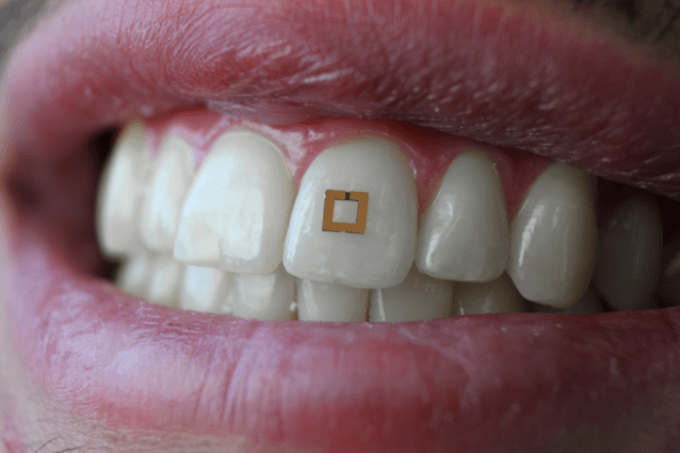Mar 29 2018
Although real-time monitoring of the processes taking place within and around our bodies could prove invaluable with regard to clinical or health care studies, it is not so easy to achieve. This scenario might soon be changed by innovative, miniaturized sensors designed by scientists at the Tufts University School of Engineering.
These sensors, upon being directly mounted on a tooth and wirelessly communicating with a mobile device, have the ability to convey information related to alcohol, salt, and glucose intake. In their study, which will soon be reported in the Advanced Materials journal, the scientists describe that further modifications to these sensors could facilitate the detection and recording of a broad array of physiological states, chemicals, and nutrients.
 A miniaturized sensor mounted on a tooth. (Image credit: SilkLab, Tufts University)
A miniaturized sensor mounted on a tooth. (Image credit: SilkLab, Tufts University)
Wearable devices developed earlier for monitoring dietary intake were restricted by drawbacks, such as the need to use a bulky wiring or mouth guard, or mandating frequent replacement due to rapid degradation of the sensors. Tufts engineers searched for a better adoptable technology and designed a sensor with a footprint of barely 2 mm ´ 2 mm that can be flexibly adapted and bonded to the uneven surface of a tooth. In a manner similar to the collection of toll on a highway, the sensors wirelessly transfer their data in response to an incoming radiofrequency signal.
The sensors are formed of three sandwiched layers—a central “bioresponsive” layer absorbing the nutrient or other chemicals to be monitored and two outer layers comprising of two square-shaped gold rings. Collectively, the three layers function like a miniature antenna, gathering and transmitting waves in the radiofrequency spectrum. When the sensors are hit by an incoming wave, a specific portion of the wave gets canceled out and the remaining portion is transmitted back, quite similar to a patch of blue paint that absorbs red wavelengths and reflects the blue back to the human eyes.
However, the sensors have the ability to change their “color.” For instance, if the central layer absorbs salt or ethanol, its electrical characteristics will get modified, making the sensors to absorb and transmit a distinctive spectrum of radiofrequency waves, with different intensity. The nutrients and other analytes can be detected and evaluated in this way.
“In theory, we can modify the bioresponsive layer in these sensors to target other chemicals – we are really limited only by our creativity,” stated Fiorenzo Omenetto, Ph.D., corresponding author of the study, who is the Frank C. Doble Professor of Engineering at Tufts. “We have extended common RFID [radiofrequency ID] technology to a sensor package that can dynamically read and transmit information on its environment, whether it is affixed to a tooth, to skin, or any other surface.”
Peter Tseng, PhD, a post-doctoral associate in Omenetto’s laboratory, who is at present assistant professor of electrical engineering and computer science at University of California, Irvine; Bradley Napier, a graduate student in the Department of Biomedical Engineering at Tufts; Logan Garbarini, an undergraduate student at the Tufts School of Engineering; and David Kaplan, PhD, the Stern Family Professor of Engineering, chair of the Department of Biomedical Engineering, and director of the Bioengineering and Biotechnology Center at Tufts are the authors of the paper.
The U.S. Army Natick Soldier Research, Development, and Engineering Center; the National Institutes of Health (NIH; F32 EB021159) National Institute of Biomedical Imaging and Bioengineering; and the Office of Naval Research supported the study. The authors are solely responsible for the content. The content does not necessarily represent the official views of the Office of Naval Research, Development and Engineering Center, the Army Natick Soldier Research, or the NIH.